Apple's 11-inch Upgraded MacBook Air: Do 1.6GHz and 4GB Make a Difference?
by Anand Lal Shimpi on November 6, 2010 2:35 AM EST- Posted in
- Mac
- Apple
- MacBook Air
- Laptops
Performance
Adobe Photoshop CS4 Performance
The Retouch Artists Speed Test we use for our CPU testing under Windows also works under OS X. We're running the exact same benchmark here, basically performing a bunch of image manipulations and filters and timing the entire process.
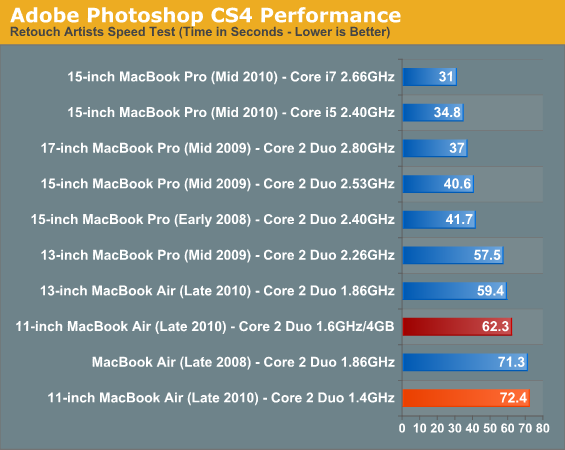
Photoshop benefits tremendously from the upgrade to 4GB. The application takes advantage of both the faster CPU and larger memory size. The combination of the two bring the 11-inch system within 5% of the 1.86GHz, 2GB 13-inch MacBook Air. A 16% increase in performance over the base 11-inch configuration. Definitely, a tangible improvement.
Aperture 2 RAW Import
For my Aperture test I simply timed how long it took to import 203 12MP RAW images into the library.
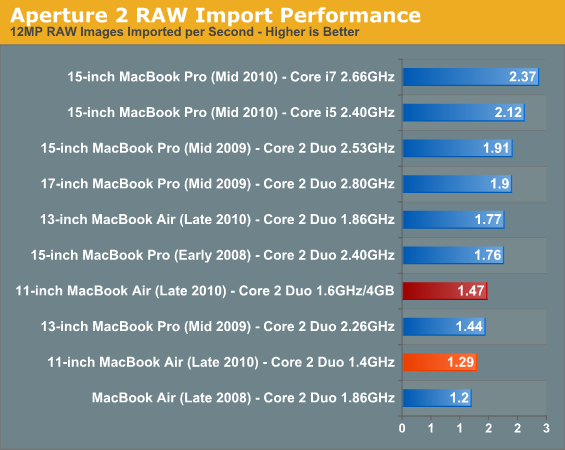
Our Aperture import test is equally impressive. We measured a 14% increase in performance over the base configuration. Although in this case, the 13-inch MBA was still 20% faster than the upgraded 11. Once more, the system didn’t only benchmark quicker, but it felt faster in use.
Cinebench R10
I’m a fan of the Cinebench test because it lets me show off both single and multithreaded performance in the same workload.
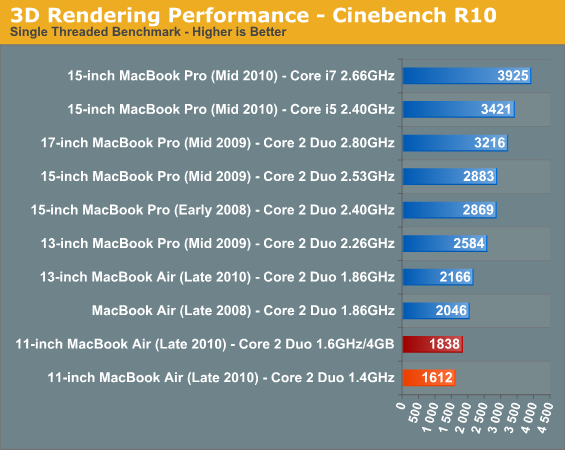
Cinebench is perfect for isolating the potential for CPU improvement. These tests are entirely CPU bound and as a result we see a ~14% improvement from the upgraded 11 vs. the base model. This is important to confirm because it means that despite the higher clock speed, Apple isn’t aggressively throttling the Core 2 in the upgraded system. If you pay for the extra 200MHz, Apple gives it to you - no strings attached.
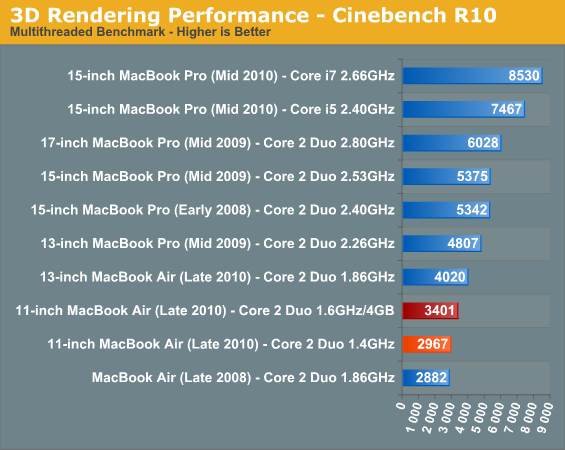

The only indication of something funny going on was our run through Cinebench 11.5. The multi-threaded score was only 13.5% higher than the 1.4GHz model, indicating that the chip most likely pulled back below 1.6GHz (likely only down to 1.5GHz).
Quicktime H.264 & Handbrake Video Encoding
Our Quicktime benchmark is more consumer focused. Here I'm taking an XviD and converting it to an iPhone-supported H.264 format.
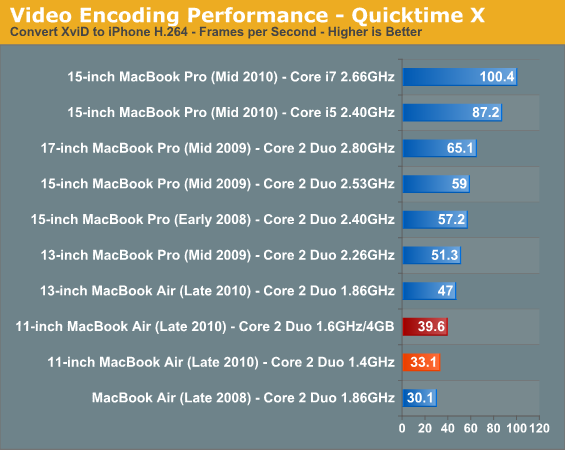
Our Quicktime transcode test proved to stress both the CPU and memory upgrades, resulting in a total performance increase of 19.4%. These are significant gains, definitely noticeable in real world use. Despite the huge improvement however, the 13-inch MacBook Air is still 18.8% faster - partly due to clock speed, and partly due to its larger L2 cache.
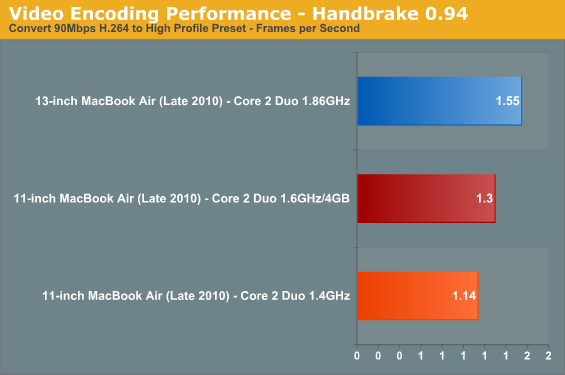
On average the upgraded system was 15% faster than the base 11-inch MacBook Air. The base 13-inch MBA averaged around 19% faster across the board, however in applications/usage models with large memory footprints the faster CPU had effectively no benefit.










85 Comments
View All Comments
Anand Lal Shimpi - Saturday, November 6, 2010 - link
As I mentioned in the conclusion, I easily paid more than this for my first Transmeta notebook (Sony's PictureBook C1VN). Back then, you expected to pay a lot for a lightweight notebook. Times have changed.To someone who needs the portability, I agree that the price is easy to justify. However if you look at it from the standpoint of what you're getting (performance-wise) for the money, it's an expensive notebook. Or as I mentioned in the original review, more of a luxury item.
Don't get me wrong, I'm one of those people who believes that paying a premium for portability is justified. I don't need to be happy about it though :) I would like to put pressure on Apple to shift prices downward. I can at least cast one vote in the too expensive column.
Take care,
Anand
right_geek - Wednesday, November 24, 2010 - link
I do hope somebody is still reading this thread.I am considering buying such a machine. I currently own 17" MB Pro, 2.66 GHz Intel Core 2 Duo, 4 GB 1067 Mhz DDR3. However, there are two problems with this machine. First, it is too heavy to carry around casually and since I commute using public transport, it is a bit of a problem. Second, beach balls appear much too often to my liking which tells me the disk is too slow (or am I mistaken?).
On a typical day, I usually use at the same time:
- IBM Lotus Notes (which is a real hog) for work-related mail;
– Mailplane for private mail;
– IBM Lotus Sametime for work-related communication;
– Adium for private communication;
- a Web browser;
– Forklift;
– NetNewsWire;
– Things;
– CoRD or Remote Desktop Connection to connect to my Windows machine at work for Windows-only programs.
Two questions then:
1) Is MB Air adequate to my needs (see above)? Will SSD memory work equally good or better then a faster processor?
2) I am sure I would like 4 GB of RAM, but is 1.6 GHz processor worth it?
Thanks in advance. Any help would be much appreciated.
mmissire - Friday, January 7, 2011 - link
I had the same machine at the same time. I had it when I met my wife, and to this day she recalls it as, "That stupid, slow little computer you had."It was awful, especially if you ugraded to Windows XP (mine shipped with Windows ME, if I recall correctly.). And I'd had such hopes for Transmeta!
acsa - Saturday, November 6, 2010 - link
What about Acer 1830t or Asus UL30 or similar? OK, you can feel that they are cheap stuff but portability and performance is great due to i5.solipsism - Saturday, November 6, 2010 - link
The Asus U30Jc is a great machine but it’s not an ultra-portable. It’s not even11.6”. I cannot find any 11.6” ultra-light notebooks* that use CULV C2D or Core-ix CPUs other than the MBAs.The closest I can find is an Acer 1830t. It’s 11.6”, uses a Core-i5, but it seems to offer no other real competitive advantage. It can be had for $200-300 less than the 11.6” MBA, but performance-wise it’s not going to be good. On top of that, it’s considerably larger and heavier than the 11” MBA which really means it’s not an ultra-light machine within the 11” footprint.
This does not mean that Acer isn’t the perfect machine for someone, but when trying to compare ultra-light and thin machines within a size class, along with other features like LCD quality, battery life, overall performance I can find nothing).
PS: Note that Intel prices that Core-i5 less than C2Ds found in the MBAs.
seanleeforever - Monday, November 8, 2010 - link
@solipsismso what makes a 11.6 inch a ultra portable not 12 inch? while we at it, how can you justify 11.6 is ultra portable when there is 8 inch PCs on the market that makes 11.6 a monster in comparison?
i think you just trying to find ways to justify MBA's price. really. the true use of ultra- portable, in addition to look cool, is to be able to work in tight places, like during flights. thickness plays very small role when you think about portability. it is weight and over all size of the package.
as to you "CULV C2D". there are plenty of them in 12/13 inch ultra portables. like the lenovo x201s/x301, which can be had for the same price as MBA at this configuration, and that is with configurations that no mac book can match to date (built in GPS, wifi, wi-max, 3 usb, vga, display port, PCMCIA , finger print reader, and, a expansion bay that you can use as secondary battery or CD rom), all for a sweet 2.48~2.93 lbs.
try stuff those parts in a macbook, pro or air, and look at how much additional weight you need to carry.
and MBA only has 2 usb, and only one is powered, are you serious... and in their infomercial keep stressing the "thinnest part", who the hell cares? i can stick a razor blade to my 17 inch elite workstation and it will be the thinnest computer according to apple standard. besides, i was a owner of x505, and you know what... it is thinner than MBA, and has 2 powered usb and pcmcia slot, a firewire port and it was available 10 years ago.
despite how great and strong the "unibody enclosure" apply claims to be, why hasn't they pass any mil spec test? or perhaps they simply cannot pass mil spec at all?
MBA is great for what it is, and it is a shinny little device, but to say it is the best is simply not true. macbook air was not the first to do ultra portable, is not the best in ultra portable, and it is not the most portable in ultra portable. and they basically recycles engineering over and over. how many years has apply use the C2D with 335? over 3 years for god sake and they still haven't moved on. and their only i7 device is suffering horribly from overheat.
solipsism - Tuesday, November 9, 2010 - link
Oh yeah, an 8” display with a full-sized keyboard? Good one¡These ultra-light notebooks are easily defined. They are considerably more powerful than any current Atom-absed setup, they have full-sized keyboards and weigh about 3lb or less.
You can say a netbook with an 8” display is just as good as these machines, but you’d be wrong. You can say that only Apple is making what you consider to be “crap” machines, but you’d be wrong.
You can say there are plenty of these machines with CULVs but you didn’t list a single machine with these 10W CPUs with full-sized keyboards. Not one!
seanleeforever - Tuesday, November 9, 2010 - link
here goes apple fan's argument. attacking without making points. posting without doing researching, saying without believing, writing with reading, doing without thinking.my post was just to show if 11.6 is your "ultra portable" what makes 12 inch not an ultra portable? i further mentioned that 8 inch pc was available long time ago, and you bring the argument back to full size keyboard, which is something you never mentioned before. (what's next? lack of apple logo?)
get the fact straight. Dell M11x also has full size keyboard. pretty much all of 12 inch laptop have full size keyboard. why do i have to list every single 12 inch notebook out there? but I take the trouble to list them JUST FOR YOU, so you can stop trolling.
take mba 11.6 for example. the package size is 11.8 *7.56*0.68, this is actually not much smaller than some of the 13.3 inch notebooks when you carry them, take ENVY 13 for example, the size is 12.6 x 8.5*0.8 (MBA 13.3 is 12.8 x 8.94, so it is actually bigger than some of the 13.3 notebook out there because it is thinner).
you mentioned the following
"10W CPUs" "full-sized keyboards" "CULV"
here are some of the machines ranging from 11.1 to 13.3 inch.
X301, SU9600 (same CPU as MBA, 10 W), best keyboard in business, with load of features i mentioned.
Toughbook T8, , 12 inch, SU9600, MIL SPEC note book, full size keyboard and weight 3~4 lbs.
HP Envy 13, SU9600, full size keyboard, a cd rom and load of connecting features.
VAIO TT, 11.1 SU9600, full size keybard. blue ray player built in, vga, hdmi, 2 powered usb.
HP TM2, SU9600, full size keyboard, 12.1 touch screen.
Asus UL30A, SU9600, full size keyboard, and load of connections.
Fujitsu LifeBook P8110, SU9600, full size keybaord, 12 inch.
i guess i made my point clear. SU9600 is used on a lot of notebooks, especially ultra portables. most of them is 12 inch that has full size keyboards. what's your next argument, Mr solipsism?
MBA 11.6 and 13.3 are great notebooks at great price. I have never denied it. they get respectable battery life and cool to look at. but they are not the best, not the most portable, and is quite expensive for the features you sacrificing. you are just paying for the "thinnest point", which i just argued that thinnest point is meaningless as i can stick a razor blade to even my desktop. i also point out how apple is basically recycle the engineering because, you know, design new MB and test them is actually quite expensive. why do it if you can sell the same thing?
and Mr. solipsism, please do some research before making another post. something like "10W CPU" is really silly. what you ought to say is 10W duel core CPU with out of order architecture. because most Atom processor, even with duel cores, have TDP of 1W to 10W. but performance wise, it will take much longer to complete the same task.
btw, the cpu used in 13.3 in MBA has tdp of 17w, which is the same as ULV core i series, but the i7 640 um is going to be at an entire different level than the SL9400.
8steve8 - Saturday, November 6, 2010 - link
thinkpad edge 11, acer timelineX, lenovo u160, alienware m11x, there are actually a good number of options.nitrousoxide - Saturday, November 6, 2010 - link
Vaio X is an extreme design, it is a purely show of engineering power of Sony, just like the Z series which packs a power-hungry-griller i7 and GT330M into a 1.3kg ultra-thin form factor. Sony doesn't actually care whether it can compete with MBA. As long as X and Z series make customers think 'WOW, VAIO is so awesome", Sony can expect a good sale on its E and F series, which is what matters the most for Sony.